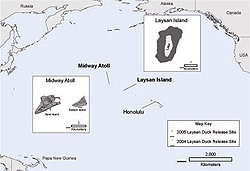This is only the third year since these highly endangered birds, also known as Laysan teal, were trapped in the wild and carefully transported by ship from their only remaining population on Laysan Island to re-establish a second population.
"These rare, wild ducks could not co-exist with rats, migrate, or disperse away from Laysan Island, so a few birds were translocated by ship to restore the species to a larger range," USGS wildlife researcher Michelle Reynolds, coordinator for the project, explained. "Now Laysan ducks are found on three rat-free islands for the first time in hundreds of years and are flying between islands at Midway Atoll."

|
| ©unknown |
| Map of study sites: Laysan Island Hawaiian Islands National Wildlife Refuge and Midway Atoll, NWR. The source population occurs on Laysan and the translocated population on Midway Atoll NWR. |
In 2004 and 2005, 42 wild, mostly juvenile, ducks made a 750-mile Pacific voyage and were released at Midway Atoll NWR, managed by the U.S.Fish & Wildlife Service (FWS), as a conservation action to increase the highly endangered duck's geographic distribution and reduce its risk of extinction. With the relocated population more than quadrupling in the first three years, researchers are now optimistic that the project will help to promote conservation of the species.
The endangered Laysan duck (Anas laysanesis) is considered the rarest native waterfowl in the United States and occurs only within the Northwestern Hawaiian Islands' Papahānaumokuākea Marine National Monument established June 15, 2006. Laysan ducks were once widespread across the Hawaiian Islands, but, by 1860, they ceased to exist anywhere except Laysan Island. Laysan Island, also protected as part of the Hawaiian Islands NWR, is a low lying island (40 feet above sea level) and home to millions of seabirds. The remote island is a five-day boat ride from Honolulu.
The re-establishment of a second or "experimental" population at Midway Atoll NWR reduces the risk of extinction from a catastrophe striking Laysan Island. The impact of a hurricane, tsunami, new diseases (such as avian flu), or the accidental introductions of harmful invasive plants and animal species could easily cause the extinction of Laysan duck as small, genetically-isolated populations. Since disaster is unlikely to strike the two populations located a significant distance apart, some security is provided for the species. Discussions are underway about the establishment of a third population relocated to another predator-free island.
Survival and breeding of the ducks was closely tracked. Each "founder bird" transported from Laysan carried a small transmitter so that it could be located despite dense vegetation. The post translocation monitoring revealed that the Laysan duck is capable of using novel habitats and flight between the small islands that comprise Midway Atoll. The endangered ducks on Midway Atoll used a wide variety of vegetation types for nesting and foraging that are not available on Laysan. "The outlook for the conservation of Laysan duck is more optimistic, given their ability to nest and forage in unfamiliar and non-native vegetation," Reynolds continued.
"We have marked approximately 115 fledgling birds with unique leg bands during August to December 2007," reports USGS bio-technician Jimmy Breeden. The banding effort this year may help the Refuge staff monitor the population status next year.
"It will soon be possible for visitors to Midway Atoll to view Laysan Teal in the wild," said Barry Christenson, FWS Midway Atoll Refuge Manager. A visitor services program will commence in at Midway Atoll 2008. The best time to view Laysan ducks is in fall and winter before they become secretive during nesting and brood rearing activities.
The USGS serves the nation by providing reliable scientific information to: describe and understand the Earth; minimize loss of life and property from natural disasters; manage water, biological, energy, and mineral resources; and enhance and protect our quality of life.
The U.S. FWS is the principal Federal agency responsible for conserving, protecting and enhancing fish, wildlife and plants and their habitats for the continuing benefit of the American people. The Service manages the 97-million-acre National Wildlife Refuge System, which encompasses 548 national wildlife refuges, thousands of small wetlands and other special management areas. It also operates 69 national fish hatcheries, 64 fishery resources offices and 81 ecological services field stations. The agency enforces federal wildlife laws, administers the Endangered Species Act, manages migratory bird populations, restores nationally significant fisheries, conserves and restores wildlife habitat such as wetlands, and helps foreign and Native American tribal governments with their conservation efforts. It also oversees the Federal Assistance program, which distributes hundreds of millions of dollars in excise taxes on fishing and hunting equipment to state fish and wildlife agencies.



Reader Comments
to our Newsletter